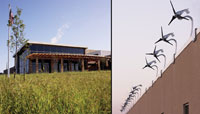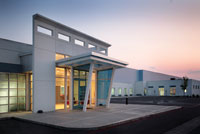

Kettle Foods (Beloit, WI) made green building choices and earned its LEED Gold certification. Its 73,000-sq.-ft. plant affords outside views to 90% of its 95 employees, and roof-mounted wind turbines (right) supply 28,000 kWh electricity. All building materials were obtained within 500 miles of the plant. Used cooking oil is converted to biodiesel. Source: Kettle Foods.
While the increase of total projects from 2006 to 2007 was significant, the percentage increase of both new projects and expansions dedicated to distribution centers and warehousing increased at a higher rate. In 2006, of the total 506 projects listed, 27 (5.3%) were for warehousing and distribution. This year, warehousing and distribution accounted for 94 of the total 613 projects or 15.2%, representing nearly a 250% increase over 2006.
Architectural and engineering firms (A/E) interviewed for this article attribute the increase in warehousing sites to a greater focus on supply chain issues that increase profits and reduce costs, such as:
Most of the A/E firms interviewed for this article said that while last year’s discussions with processors focused on issues such as using less energy and fewer resources, having more efficient plants and cutting costs, current discussion centers around LEED (Leadership in Energy and Environmental Design). A third-party certification program for the design, construction and operation of high-performance green buildings, LEED encompasses sustainability issues and expands on them. Originally devised more for homes, commercial and public buildings than industrial plants, the US Green Building Council’s LEED Green Building Rating System encourages and accelerates global adoption of sustainable green building and development practices through the creation and implementation of universally understood and accepted tools and performance criteria.
Just about every A&E/construction firm interviewed put LEED at the top of its list when it came to the issues food processors want to discuss. Other issues such as cleanliness, efficiency and automation remain important, but the components that make up the LEED-registered project checklist provide processors with criteria to measure their plants’ sustainability and gauge how energy efficient their facilities are, all of which adds up to energy and utility savings and a better public image.
Darrin McCormies, A. Epstein and Sons senior vice president, says the majority of his firm’s food and beverage customers in the last two years are either asking about LEED certification or expecting it with new projects. This is quite a departure from a few years ago when few of Epstein’s clients were familiar with the LEED program. McCormies sees this trend increasing as LEED becomes the yardstick by which buildings of all types are measured, and adds his clients perceive two key benefits. “First, if a building is designed to achieve a certain level of LEED certification, its total energy consumption and operating costs will be lower. Second, conserving our resources is the right thing to do and having a LEED-certified building announces to the public our client’s green commitment.”

Contessa Premium Foods (Los Angeles, CA) opened its “Green Cuisine” 115,000-sq.-ft. frozen food processing/packaging facility late last year, the first of its kind to receive a LEED Gold Certificate. A 310 kW solar array offsets more than 80% of electricity used in the office areas. R-30 insulation is used in the ceiling, and R-19 is used in the walls. Variable frequency drives are used in the cooling systems to save energy. Source: Contessa Premium Foods.
Healthy image
While LEED adds to the cost of the design/build experience, LEED initiatives save energy in the long run and provide an aura of good stewardship in the community. Haskell Director of Process & Regulatory, Darryl Wernimont, notes green, sustainable and LEED initiatives reinforce a company’s commitment to the community and its employees, thus creating goodwill and enhancing the reputation of the business and its relations with its clients. He adds that green initiatives can result in a healthier environment for a business’ employees, thus improving the quality of life of employees, and in return, the success of the business itself.LEED is fast developing a public image. Bob Graham, VP, food and beverage, The Austin Group, says that processors need to become LEED-aware as retailers seek to display a more healthful public image. “Those processors that deal in fresh, agricultural products, organics, etc. and those that sell to the national big box chains such as Costco and Wal-Mart are being pushed in a ‘top-down’ effort to be more LEED-conscious in plant design and production.”
Today, most processors are up to speed on LEED concepts, but that wasn’t always the case. “Seven years ago only one in 50 clients I spoke with was knowledgeable and/or interested in LEED,” says Wernimont. “This past year, 80-90% were not only knowledgeable on the subject but felt sustainable initiatives needed to be a part of their construction and/or existing building initiatives.” (For more on LEED guidelines, see the sidebar on page 68.”)
“Sustainable” seems to be the operative word. According to John McLaughlin, VP, BE&K Building Group, actual LEED certification seems not to be as critical to the food and beverage community as the overall concept of sustainable design, which should be a major consideration before beginning construction. While many processors may not necessarily care specifically about LEED certification, they do demand the utmost efficiency in new plant design, says Bob Simpson, VP of process engineering, Excel Engineering. Simpson says his firm has been using LEED practices for five years-even though a customer may not know how to ask for them.
According to Annie Meyer of Power Engineers’ business development sector, clients are certainly asking for LEED guidance-even on minor expansions. “They’re looking to get on the map for energy savings, but many are content to achieve a solid level of sustainable building design without the effort required for certification.”
“Getting LEED certification can be tricky,” says Karl Landgraf, partner at The Dennis Group, who reminds processors that the LEED rating doesn’t happen until the project is completed and audited. Thus, if some LEED requisites were missed in the project planning stage, it’s possible the project may not rate as highly as expected during the audit. Plus, bringing the project up to snuff afterward may increase costs.

This new Land O’ Frost facility in Madisonville, KY incorporates AMI 11 principles of sanitary design. The 191,000-sq.-ft. plant produces ready-to-eat meat products. Source: Haskell.
Cost factors
As the design and construction industry continues to produce more sustainable buildings, the cost and schedule impacts of LEED are being reduced. According to McCormies, achieving basic LEED certification should only increase the overall budget by a few percent, and there should be little or no impact on schedule. To achieve higher levels of LEED certification, however, costs will increase, and in these tight times, even as little as a 3% increase in costs for LEED certification can be a tough sell to some processors. William Vaughn, principal, VCP&A, suggests energy-saving plant designs can still be done with sustainability in mind, without necessarily incurring the additional expense LEED certification requires.Costs may depend on geographical location and availability of resources. Gary Smith, chairman of Webber-Smith Associates observes a growth in requests for LEED certification but even more interest in LEED qualification-where green techniques are used but certification is not needed. “Until green design is the everyday norm, we will continue to see an increase in engineering costs of approximately 15%. We will also see an increase in construction costs.” Project delays can sometimes happen if specific materials are not available or are not available within a reasonable distance from the project.
Additional costs for LEED initiatives can come from unexpected places such as increased documentation. Harlan VandeZandschulp, Gleeson Constructors president, speaks of a 300,000-sq.-ft. production plant project in Dubuque, IA. “Concrete paving and a white TPO (thermoplastic olefin) roof would normally be used on our projects, but the use of white surfaces needs to be documented for LEED [accreditation] points. The documentation is the costly and time-consuming part of LEED design.”
LEED initiatives don’t necessarily slow a schedule, but processors must invest up front to get energy savings. “For those projects that required LEED certification,” says Vince DiPofi, SSOE senior VP, “we have not seen a significant impact to the timeliness of the projects, but the cost has increased somewhat due to the energy-savings equipment such as heat exchangers to capture waste heat.” The additional cost, however, has an acceptable payback period and actually helps with the economic justification of the projects. DiPofi has seen customers willing to go to two years’ ROI, particularly for quantifiable/measurable energy savings.
William Sander, Hixson senior VP and project manager, says processors are more willing than before to look at long-term paybacks rather than expect a short-term ROI when it comes to sustainability issues. This includes, for example, the purchase of equipment for re-circulating water and for more efficient HVAC design. While LEED is not the primary driver for all of Hixson’s clients, most are evaluating sustainability alternatives that can lead to energy/utilities savings.
“More often projects are not justified on LEED or ‘green’ standards by themselves,” adds DiPofi. “Typically the customer wants to incorporate sustainable design into a new project that was justified under other criteria.”
Sustainable design might include investments in generating alternative energy where practical. For example, Mike Golden, Food Tech Structures executive VP, points to two applications for solar: one in the Bronx that produces a minor amount of power and one in central California that actually produces a surplus of power, spinning the meter backwards. In China, Food Tech completed a 40,000-cubic meter waste water treatment system for a food process plant which produces biogas as a byproduct of its anaerobic system. The biogas is collected and then directed to a combination biogas and propane boiler. The boiler provides necessary steam back to the heating system and waste water treatment system facilities.
Up-front design is critical
Meyer notes a significant trend away from design/build contracts in favor of more traditional design/bid/build execution methods. She attributes this to the extreme cost and cash flow pressures facing food and beverage clients. Smith agrees and adds that processors are looking for quality-based design decisions-not cost-based decisions. He also notes an increase in the number of projects where processors are willing to spend more on better materials, such as pre-cast concrete, brick flooring and tiled walls. He believes this may be the result of growing costs for maintenance, repairs or replacement of lower-cost building materials.While giving processors multiple choices in material selection, it’s really important to put the emphasis on the costs/benefits of the materials being discussed, says Jim Larva, project manager at Hendon & Redmond. Engineering in the value up front saves time and money down the road and helps prevent the maintenance issues Smith describes.
A big help in early design is building information modeling (BIM). According to Facility Group’s David Dixon, senior VP, food and beverage, BIM reduces costs and errors while accelerating schedules. It also drives integration among designers, contractors and suppliers. BIM supports sustainability since the model allows quicker analysis of the alternative approaches for reducing carbon footprint using solid data. Several processors today demand all contractors and vendors are BIM-proficient, and the BIM model is also used for communication and issues resolution.
Long-term planning for automation
Designing a building isn’t the only task that needs up-front and long-term planning. DiPofi suggests that if a processor is committed to LEED strategies, the process control system is just as important as the building. Excel’s Simpson advises creating a five-year automation plan with a working block diagram that allows for planning on the maximum automation available, even if it isn’t purchased in the initial project. This allows the incremental addition of automation without any unexpected snafus.Keeping automation system costs low is a function of a combination of control equipment, system engineering, installation of the system and cost of ownership after the system is installed, says Mark Shambaugh, CEO of Shambaugh & Son. Product recovery, which can be automated within the process design, is a standard operating procedure for both process and clean-in-place (CIP) design. Another way to keep automation costs low is early project definition. When developing a control strategy, the automation system must address both a processor’s production and regulatory needs. Keep in mind, however, that when processors venture from the “must have” to “would like to have” category, automation prices can take off.
Sander suggests several tips for delivering efficient automation:
Processors should consider equipment that reduces the labor necessary for cleaning and sanitizing, and follow the guidelines set forth by organizations such as AMI, BISSC and 3A. These guidelines include using solid (not hollow) structural members, minimizing the use of horizontal surfaces and making certain equipment seams are fully welded and ground smooth and equipment can be easily disassembled for cleaning. The guidelines also recommend preventing hidden areas where debris or water could accumulate, providing an environment for growth of microorganisms.
According to Kevin Lewis, president, Case, Lowe & Hart, the economics of clean building and utility services are always a challenge. “We are always looking for better and more long-term, cost-effective solutions to making the building and finishes cleanable and durable.”
Just as modular and scalable processing equipment makes sense, modular, scalable control system design is the key to efficient automation, says DiPofi. This design architecture consists of modules that are similar across the product flow stream from bulk material handling, mixing and batching to packaging and shipping. Use of modular programming code and HMI screens allows a seamless transition through different areas of production within the plant. This standardized approach lends itself well to overall maintainability of the system after engineering and construction are completed and provides a common look and feel of the systems throughout the plant, minimizing training and errors. This basic system design is scalable from an enterprise standpoint, thus reducing initial costs as well as being flexible for future modifications.
Finally, flexible automation works best if the plant is designed to be flexible. According to Greg Crnkovich, Austin Group director of planning, food and beverage, the overriding design principle is efficient flow of materials through the plant, minimizing travel distances between storage and input points in the process. Flexibility in set-ups allows for quick changeovers, but there can be a trade-off between flexibility and cost-of-construction regarding floor space. Also, shipping finished product should be as highly automated as possible and should use AS/RS technologies to build loads.
While automation remains an area of intense discussion, the last year brought an explosion of interest in LEED. In fact, an appropriate question might be, “Can your organization afford not to take advantage of LEED’s guidelines?” Whether it’s saving energy, maintaining a cleaner plant, reducing water treatment costs or maintaining a better image with your employees, customers and community, LEED provides sustainability standards that are long overdue.
LEED checklist categories
The US Green Building Council awards four levels of recognition based on points earned for complying with its LEED guidelines. These levels in descending order are Platinum, Gold, Silver and Certified. Categories for which points can be earned are briefly reviewed below.Sustainable sites: Criteria include construction activity pollution prevention, site selection, development density and community connectivity, brownfield redevelopment, alternative transportation concerns (public, bicycle, fuel-efficient vehicles, parking capacity), site development to protect and restore habitat while maximizing open space, storm water considerations, heat island effects, light pollution reduction.
Water efficiency: Water-efficient landscaping, innovative wastewater technologies, water use reduction.
Energy and atmosphere: Commissioning of building energy systems, minimum energy performance, fundamental refrigerant management, optimized energy performance, on-site renewable energy, enhanced commissioning and refrigerant management, energy performance optimization, on-site renewable energy, measurement verification, green power.
Materials & resources: Storage and collection of recyclables, building reuse, construction waste management, materials reuse, recycled content, regional materials, rapidly renewable materials, certified wood.
Indoor environmental quality: Minimum IAQ performance, environmental tobacco smoke control, outdoor air delivery monitoring, increased ventilation, low-emitting materials, indoor chemical and pollutant source control, controllability of lighting and HVAC systems, thermal comfort, daylight, views.
Innovation in design: Provide specific title and use LEED-accredited professional.
For more information, www.usgbc.org.
The following companies assisted Food Engineering in compiling this survey:
The Austin Company
Robert Graham
404-564-3950
BE&K Building Group
John McLaughlin
864-250-5098
E.A. Bonelli + Associates, Inc.
Curtis Manns
510-740-0155
Andrew W. Booth & Associates
Andrew W. Booth
410-742-7299
Case, Lowe & Hart
Kevin J. Lewis
801-399-5821
The Dennis Group
Alyssa Boudreau
413-787-1785
A. Epstein and Sons
Darrin McCormies
312-429-8411
Excel Engineering
Bob Simpson
920-926-9800
Facility Group
David Dixon
770-437-7585
Faithful & Gould
Jonathan Marshall
612-392-3515
Food Technology Structures
Mike Golden
781-929-7369
Gleeson Constructors
Harlan VandeZandschulp
712-258-9300
Haskell
Darryl Wernimont
904-357-4820
Hendon & Redmond
Jim Larva
513-641-0320
Hixson
Bill Sander
513-241-1230
Middough Consulting Inc.
Jim Bingham
630-756-7006
Power Engineers
Annie Meyer
208-685-6201
Shambaugh & Son
Mark Shambaugh
260-487-7807
SSOE
Vince DiPofi
419-255-3830
Stellar
Mark Sherwood
904-899-9345
VCP&A
William O. Vaughn
770-938-2600
Webber-Smith Associates
Gary Smith
717-291-2266
Click here for the Construction Chart.


